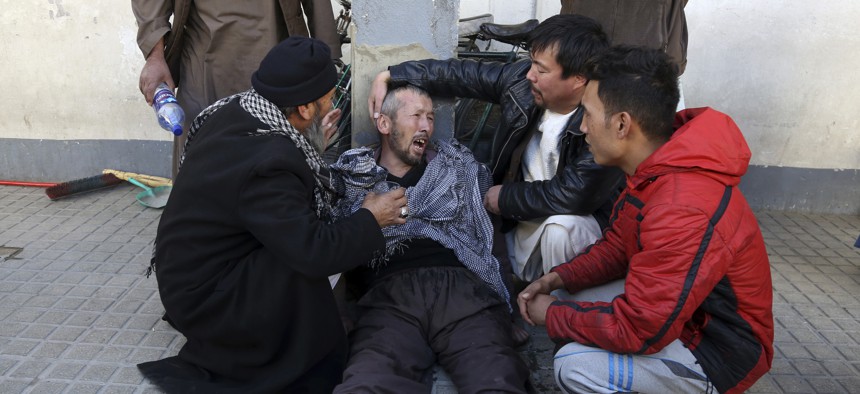
A distraught man is cared for outside a hospital following a suicide attack in Kabul, Afghanistan, Thursday that killed dozens. Rahmat Gul/AP
ISIS in Afghanistan Is Like a Balloon That Won't Pop
Thursday’s fatal attack in Kabul highlights the group’s resilience.
ISIS should have been eliminated in Afghanistan. That’s what Americans will tell you, anyway.
In April, the U.S. military said that only about 700 ISIS fighters remained in the country and then proceeded to drop the “mother of all bombs,” one of the largest non-nuclear devices, against an ISIS facility in Afghanistan. Three months later, the U.S. military said it had killed Abu Sayed, the head of ISIS-Khorasan, as the group is known in the country, during an airstrike in June. At the time, a Pentagon spokeswoman said the U.S. actions “will significantly disrupt the terror group’s plans to expand its presence in Afghanistan.”
Less that six months later, ISIS has not only survived, but it has also showcased its ability to strike at the heart of the Afghan state. On Thursday, the group claimed responsibility for a suicide-bomb attack on a Shia cultural center in Kabul, the Afghan capital. At least 41 people were killed and more than 80 more were wounded. Those killed included students who had gathered for a discussion to mark the 38th anniversary of the Soviet invasion of Afghanistan (Christmas Day, 1979). Journalists from Afghan Voice, a Shia-affiliated news agency, were also among the dead. ISIS regards the Shia as apostates, and has frequently targeted Shias around the world.
There have been similar attacks in recent weeks and throughout the year. On Christmas Day, ISIS struck near an office belonging to the Afghan intelligence service, killing six people. On December 18, gunmen from the group stormed another intelligence center in Kabul, but that attempt ended with all three attackers being killed.
All this comes even as the Taliban, which governed Afghanistan before it was toppled in 2001 following the U.S.-led invasion, is still the primary militant group operating in the country. The Taliban still has control—and support—in large parts of Afghanistan.
So while the Islamic State’s attacks in Afghanistan are shocking, none of them should be the least bit surprising. After all, the type of geopolitical stability that the West takes for granted is rare in the vast majority of the world. The U.S. has taken upon itself to bring stability to many of these places—with mixed results. It has toppled dictators in Iraq and elsewhere, but has yet been unable to bring about the kind of political stability needed for a functioning state and civil society. Afghanistan, in particular, has shown the limits of U.S. involvement in a country. President Donald Trump, after advocating for a withdrawal of American troops from Afghanistan, did what his predecessor, Barack Obama, did: doubled downinstead. About 15,000 U.S. troops are now in the country, more than 16 years after the United States first entered Afghanistan.
“A hasty withdrawal would create a vacuum that terrorists, including ISIS and al-Qaeda, would instantly fill, just as happened before September 11th,” Trump said in August as he unveiled his Afghan strategy. He added that the U.S. would move away from the Bush-era policy of the U.S. as a force that spreads democracy overseas. “We are not nation-building again,” he said at the time. “We are killing terrorists.”
The U.S. and its Afghan military partners have succeeded in that endeavor. In October, U.S. aircraft dropped 653 bombs, missiles, and other munitions on Taliban and ISIS targets, according to U.S. Air Forces Central Command. The number for October 2016 was 203. Still, it’s not clear if the rate at which the U.S. is “killing terrorists” in Afghanistan exceeds the rate at which ISIS-K is growing.
Michael Kugelman, the deputy director of the Asia Program at the Wilson Center, tweetedafter Thursday attack that ISIS’s resilience in Afghanistan, despite “relentless” airstrikes, is “quite worrying.” He attributed the group’s strength to the Afghan terrain, which allows fighters to evade strikes; a “steady supply of recruits from disaffected” members of the Pakistani Taliban; as well as “homegrown radicalization.”
Last month, General John Nicholson, the top American and NATO commander in Afghanistan, said U.S. operations had removed more than 1,600 ISIS fighters from the battlefield since March—more than twice the previous estimate of 700 fighters total. The general acknowledged the difficulty of fighting the group, which has gone from being confined to its strongholds in the eastern part of the country to carrying out attacks in places like Kabul.
“It’s like a balloon,” Nicholson said. “We squeeze them in this area and they’ll try to move out elsewhere.”




